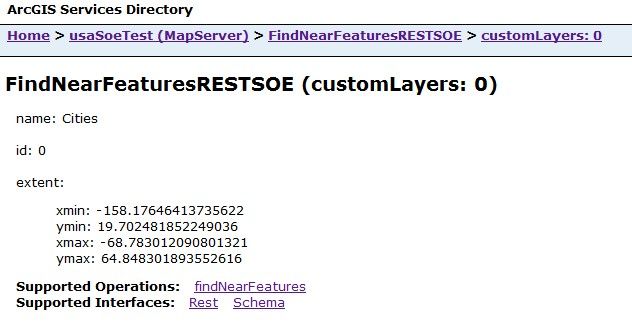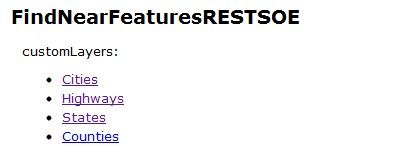SOE中三个重要概念:Schema、Resource、Operation。
前面几节我们介绍了SOE基本概念、REST SOE模板以及如何处理输入输出数据。今天详细介绍一下SOE中三个重要概念:Schema、Resource、Operation。
1.Schema
SOE中的Resource和Operation所组成的结构就是Schema,也可以说Shcema确定了SOE中Resource和Operation的层次结构。通常由IRESTRequestHandler接口的GetSchema()方法来返回该SOE的Schema,作为一个JSON格式的字符串被返回。在REST API中可以通过讲一个http请求的参数设置为“f=schema”来获取Schema。
下面我们来看几个Schema的例子
Schema1 只有一个Operation
{
"operations" : [ "buffer", "near" ]
}
在该例子中,SOE之暴露了一个Operation,从REST API角度来讲,这个SOE之暴露了两个URL。SOE跟资源和Buffer Operation:
http://<service-url>/exts/<extensionName> //root SOE resource http://<service-url>/exts/<extensionName>/buffer //buffer operation
Schema2 有多个Operation
{
"operations" : [ "buffer", "near" ]
}
在该Schema中Operation是一个数组,所以可以指定多个操作。从REST API角度来讲,这个SOE暴露了三个URL、SOE跟资源、Buffer和near操做:
http://<service-url>/exts/<extensionName> //root SOE resource http://<service-url>/exts/<extensionName>/buffer //buffer operation http://<service-url>/exts/<extensionName>/near //near operation
Schema3 具有参数的Operation和它指定的参数以及输出格式
{
"operations" : [
{
"name" : "buffer",
"parameters" : ["location", "distance"],
"supportedOutputFormats" : ["json", "amf"]
},
{
"name" : "near",
"parameters" : ["location", "distance", "lookingFor"],
"supportedOutputFormats" : ["json"]
}
]
}
它同Schema2暴露的URL是一样的,区别在于它不仅制定了Operation的名称,还有一些Operation的附属信息,稍后我们会继续讨论这种Schema。
Schema 4 子Resource
{
"name" : "MyMapServiceExtension",
"operations" : ["export", "identify"],
"resources" : [
{
"name" : "metadata"
},
{
"name" : "layers",
"isCollection" : true,
"operations" : ["query"],
"resources" : [
{
"name" : "features",
"isCollection" : true
}
]
}
]
}
该Schema中除了Operation外,还指定了它的子Resource。该SOE包含两个根级Operation:export和identify,同时也包含了两个子资源: metadata和layers。
metadata资源可以通过以下URL获得:
http://<service-url>/exts/<extensionName>/metadata
注意到layers是一个Collection Resource(集合资源,因为其isCollection属性为true),可以通过以下URL访问它的子图层资源:
http://<service-url>/exts/<extensionName>/layers/<layerId>
同时,每一个图层都支持query操作,如下URL:
http://<service-url>/exts/<extensionName>/layers/<layerId>/query
每一个图层中又包含了features子资源。features也是一个集合资源,每个特定的feature可以通过以下URL访问:
http://<service-url>/exts/<extensionName>/layers/<layerId>/features/<featureId>
2.Resource
所有的SOE服务最少支持一个根级的Resource和Operation,如果Schema指定的话也可以包含子资源。
REST handler经常会从SOE中获取一个resource的json表达。如果客户端使用“f=json”开请求一个resource,SOE将会以json格式发送到客户端。另一方面,如果使用Services Directory显示的话,通常会将json转换为html形式显示在网页上。
现在假定通过SOE返回的json格式的根资源如下:
{
"description: "Contitental US",
"extent" : { "xmin" : ..., "ymin" : ..., ...},
"spatialReference" : {...},
...
"layers" : [
{ "id" : 0, "name" : "Cities", ... },
{ "id" : 1, "name" : "Counties", ... },
{ "id" : 2, "name" : "States", ... }
]
...
}
当其在Services Directory中显示时,Rest handler会发现一个“layers”属性,由于他在Schema中被指定作为Collection Resource,将会首先检查这个属性(layers)的值是否是一个json数组,进一步检查每个元素是否是一个具有id和name属性的json对象。这样将会用他的name作为显示而将id放在放在URL连接中。点击Cities时会获得如下URL:
http://<service-url>/exts/<extensionName>/layers/0 //the Cities layer
在Services Directory中如下显示:
使用REST API获取一个SOE的resource,实际上是触发了SOE中的handleRESTRequest方法。对于resource请求,该方法的OpeartionName参数将是一个空字符串,而resourceName参数是一个跟SOE的resource相关的字符串。下图展示了在Schema4中对于不同的resource的REST请求,将被转换成handleRequest触发时的resourceName参数:
3.Operation
如果SOE的Schema中指定了某些resource支持Operation,该resource的Services Directory页面将会显示出Operation的链接。如:
在Schema2中之定义了一个Operation的名字,并没有参数和返回格式信息,这时Services Directory通常会显示一个form,用户需要在此提供参数信息和值,在Schema中的buffer Operation将会如下显示:
类似resource,用REST API发送Operation请求时也触发了HandleRESTRequest方法。这时候operationName将是一个非空字符串,resourceName将是一个与SOE的resource有关联的字符串。在Schema4中,发送不同的Operation请求,将被转换成handleRESTRequest触发时的resourceName和operationName:
REST客户端会把operation参数作为query parameter放在URL中。在handleRESTRequest出发之前,REST handle将输入参数强制转换成json对象,参数名作为json对象的属性名,参数值作为有意义的json对象值,如数字、bool、json对象、json数组,如果不能转换成上述类型则转换为字符串。handleRESTRequest中的outformat参数设置为“f”指定的类型。
http://<service-url>/exts/<extensionName>/near? location={x: -117.05, y: 34.11}&distance=2.5&&lookingFor=ATM&f=json
上述请求中,location参数将会被转换成json对象,distance被转换成数字,lookingFor将被转换成string。在触发handleRESTRequest方法之前,operationInput参数将被转换成如下json对象:
{
"location" : {x: -117.05, y: 34.11}, //JSON object
"distance" : 2.5, //number
"lookingFor" : "ATM" //string
}
以上就是这节要说的内容,特别声明一下,本篇内容并非原创,大部分内容参考了这篇文章:
http://atlas.resources.ca.gov/arcgis/SDK/REST/extension.html






